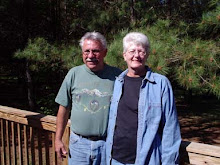Leaving Michigan, we have traveled through Wisconsin, Minnesota - Bemidji - birthplace of Paul Bunyan and Babe the Blue Ox
and now into North Dakota - a new state for us. We stopped at Rugby, ND - the Geographical Center of North America.
We spent last night in Saginaw, Minnesota and tonight we are staying in Michigan City, ND. The weather has been great, the land is getting more interesting and we are enjoying ourselves and each other as we travel west.
We stopped at the Lewis and Clark Interpretive Center to see the Hiditsu Indian Villages. This is
where Sakajawea came from. However, in going through the center we learned that her name is actually pronounced - Sa-KA-ka-WE-a. The Hiditsu tribe do not have a gee or ja sound in their language. Interesting how the white man has twisted things through non-understanding.
The villages are no longer, but the circles are there where the mounds were. This is one of the tribes that did not live in tipi's. They built these huge earthen structures - wood frame on the inside with 12" of dirt and sod on the outside - that housed up to 30 tribe members.

In the winter they moved down towards the Missouri riverbanks and built smaller lodges because that location was more protected in the winter weather. These lodges were usually torn down or destroyed afterwards when they moved back up on the higher level and the next winter season, they built new, smaller lodges.
There were three locations where the villages were built - one was smaller with only about 20 lodges, the other two had many more.
The lands of North Dakota are extremely interesting. When I thought of the state before, I pictured farm lands and not much of anything else. Not so! North Dakota has abundant wetlands due to Devil Lake. The water was drained to make more farmland and rerouted and what actually happened is it made more wetlands. Farmers are losing up to 1/3 of their acreage and have been trying to get the Canadian government to allow them to drain the excess water into the river. The Canadian government is totally opposed to this so guess North Dakota is stuck with the problem.
We have seen many waterfowl as we passed through - to name a few; Common Merganser, Mallard, Black Scoter, Canvasback, Northern Shoveler - all ducks - Canada Geese, Red Winged Blackbirds, 3 Pheasants, Cormorants, Blue Heron, Snow Geese, Hawks, 2 Eagles, 6 Deer and 1 fawn.
Oh yes - one other thing happened - as we were getting set up at the Corps of Engineer Campground, Ken noticed one of the trailer tires had a big bulge in it - so off to Bismarck, ND in the morning to buy a tire. Then from there we head to the Theodore Roosevelt National Park and the National Grasslands.
 The red color you see on top of the "hills" is caused from lignite coal burning below ground. You can't actually see anything burning - smoke or flames - but it is there. It is easy to imagine how hard it would be to find your way out of this area. The Painted Canyon is also known as the Badlands of North Dakota.
The red color you see on top of the "hills" is caused from lignite coal burning below ground. You can't actually see anything burning - smoke or flames - but it is there. It is easy to imagine how hard it would be to find your way out of this area. The Painted Canyon is also known as the Badlands of North Dakota.







 On the bridge . . . . . . . . . . . . . . . . . . . . . . . . . . . . The ferry to Mackinac Island
On the bridge . . . . . . . . . . . . . . . . . . . . . . . . . . . . The ferry to Mackinac Island





